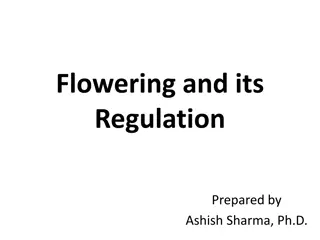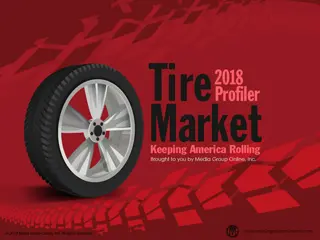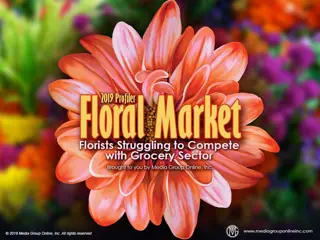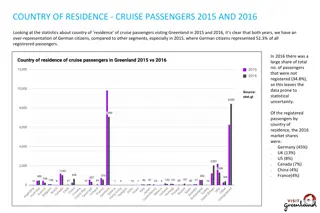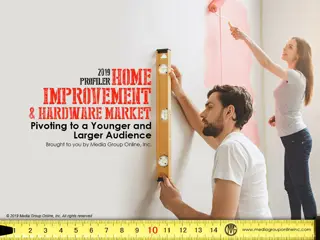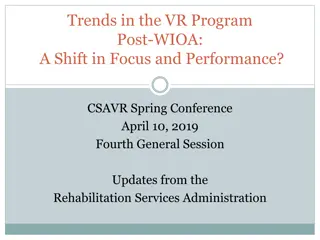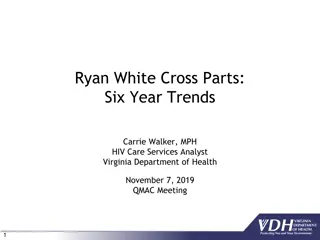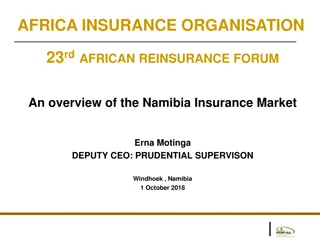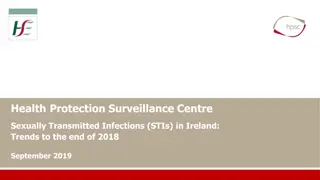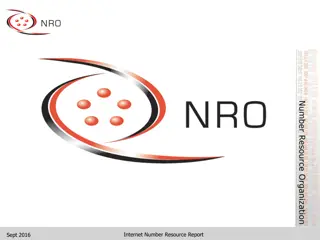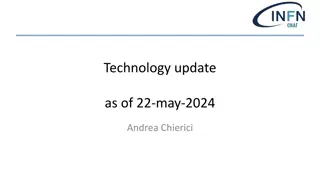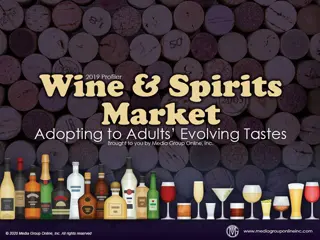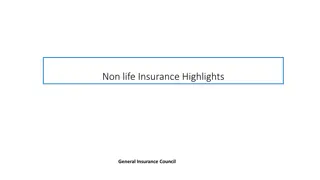Trends in the Floral Industry: 2016-2018 Insights
The US floral industry saw growth in sales, with an increase in consumption of flowers, seeds, and potted plants. Valentine's Day and Mother's Day trends showed higher spending, while Millennials' preferences are shaping the market. Wedding floral spending also increased in 2016, with evolving trends for 2018 emphasizing greenery and organic elements.
Download Presentation

Please find below an Image/Link to download the presentation.
The content on the website is provided AS IS for your information and personal use only. It may not be sold, licensed, or shared on other websites without obtaining consent from the author. Download presentation by click this link. If you encounter any issues during the download, it is possible that the publisher has removed the file from their server.
E N D
Presentation Transcript
Sales Are Sprouting According to the US Bureau of Economic Analysis (BEA), US consumption of flowers, seeds and potted plants was $30.769 billion for 2016, a 3.93% increase from $29.591 billion for 2015. This was an improvement from the previous year s increase of 2.88%. The Society of American Florists (SAF) reported that floriculture retail sales during 2015 were $31.3 billion, an increase of 1.3% from 2014. The discrepancy could be from florists sales of non-plant gift items that were not included in the BEA report. There are approximately 16,182 floral shops in the US, with average annual sales of $322,331 per shop. Wholesale florists and suppliers surveyed were optimistic about 2017 sales: 62.5% expected an increase, 16% flat and 6% a decrease.
Valuable Valentines Day Valentine s Day 2017 was a Tuesday, which is one of the top days of the week for flower purchases and deliveries because of deliveries to loved ones at their workplaces. Although the percentage of households buying flowers for Valentine s Day has decreased during the years (48% projected for 2017), the increase in the number of American households has helped to offset the decrease. Households with people younger than 35 and those with teenagers are the largest buyers of flowers for Valentines Day, at 63% for <35 households and 58% for homes with teens.
Making the Most of Mother s Day Mother s Day 2017 was great for florists. Approximately 35% of Americans bought flowers and plants as gifts, and spent more an average of $59.30, compared to $50.10 during 2015, when the survey was last conducted. Supermarkets continued to be the top sales channel, but their share decreased from 45% to 42%, while retail florists share spiked from 17% to 26%. Garden centers were third at 22%, an increase from 18%, and mass merchandisers, steady at 17%. The average amount spent at retail florists for Mother s Day 2017 was $78, an 11.3% increase from $70.10 for Mother s Day 2015.
Understanding the Millennial Buyer According to a report from the Produce Marketing Association, Millennials view flowers as the choice of older adults and prefer to give other types of gifts; however, Millennials enjoy flowers themselves and like, but can t afford, artistic arrangements. The best ways to attract Millennial customers is to host fun activities and in-store events, create a casual space and let them arrange their own flowers and design packaging. Florists can be more visible by partnering with other businesses and events. Millennials prefer to buy flowers in person at local florists, 69%; grocery store/mass merchandisers, 63%; farmers markets, 57%; or nursery/garden centers, 50%. When ordering online, they like local florist Websites, 35%, or national floral retailers, 34%.
Flowers Help to Make Weddings Unique The Knot 2016 Real Weddings Study reported a 10.2% increase in the national average spent on the florist/d cor, from $2,300 for 2015 to $2,534 for 2016. The 2016 Wedding Report found that only event centerpieces decreased in average cost, by 1.4%, while bridal bouquet increased 2.7%; bridesmaid bouquets, +5.0%; table centerpieces, +0.3%; and flower girl flowers, +4.2%. The top floral wedding trends for 2018 include living greenery bouquets with organic succulents and delicate white flowers; floral chandeliers, wall decorations and archways; and mixed flowers in vibrant tones and shapes as bouquets and flower crowns.
A Cluster of Business Challenges For Millennials, buying in grocery stores and mass-market stores is a matter of convenience. Almost 60% said it is convenient to buy flowers while grocery shopping and a similar percent cited the convenient location of grocery and mass-market stores. Price is a major barrier for 75% of Millennials, especially when buying for themselves. Approximately half say that flowers are overpriced at local florists. Consumers said they would definitely buy more flowers if there were discounts, coupons or sales promotions. After price, the next biggest reason for not buying flowers is short longevity, with 61% citing it as a top-three reason.
Advertising Strategies When not targeting a major floral holiday, advertising messages can position flowers as a thoughtful way to brighten a female friend s day or celebrate a birthday, career promotion or other life milestone. Conduct flower-arranging workshops in store to drive traffic and sales, including a DIY flower bar with stems, vases and embellishments sold a la carte. Partner with other businesses, such as home d cor stores and outdoor cafes, to showcase and sell your flowers.
New Media Strategies Conduct flower-arranging events in store and virtual events in home. Ask all participants to post photos or videos of their arrangements online, so your social media audience can vote on the most colorful, decorative, etc. Award discounts to winners for their next purchase. Send monthly emails to subscribers with the flower(s) of the month, paired with a beautiful thought or inspirational quote. Create truly unique flower arrangements, and then hire a photographer and sell the photographs as cards, calendars, computer wallpapers, smartphone themes and other merchandise to position your shop as trendy.


